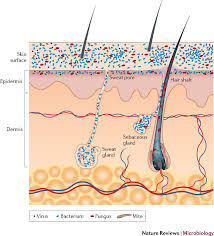ACNE VULGARIS is a common condition affecting many young adults from early teens up to their mid-twenties. Nutritional medicine is effective against acne-prone skin and can play a significant role in calming the skin and reducing acne eruptions. Be informed of the latest in nutritional treatments available to help you understand and control what may otherwise be a most frustrating condition.
WHAT IS ACNE?
ACNE is a multifactorial disease of the pilosebaceous unit in the skin. The sebaceous or oil-secreting gland at the base of hair follicles is connected to the surface of the skin by the sebaceous duct through which the hair passes.
The most common form of acne is ACNE VULGARIS affecting mainly those in their teens and mid-twenties. Other types of acne include:
- ACNE COSMETICA due to the heavy use of cosmetics.
- Cloracne is the result of the action of industrials oils and chlorinated hydrocarbons.
- Acne conglobata is a severe form of acne that occurs in later life causing multiple blackheads and extensive scarring leaving keiloid lesions.
- Acne fulminans is an immunological condition that affects mainly adolescent males.
- ACNE ROSACEA leads to erythema (redness of the skin) and telangiectasia with or without acneiform components. It is a chronic type of acne affecting adults usually over the age of 40. Rhinophyma (thickening of the nose) is a known complication due to glandular hyperplasia.
WHAT CAUSES ACNE?
ACNE VULGARIS
Acne is the result of overactivity of the oil glands of the skin, particularly those located on the face, neck, back and shoulders. These glands become clogged by skin cells that block the opening of pores. It is now known that there are 3 key factors that play a role in acne.
- The typical teenage outbreak of acne (hormonal acne) is due to the hormonal stimulation of the oil glands that causes them to be overactive. These glands will then secrete excessive amounts of sebum, a mixture of oils whose function is to lubricate the skin and prevent water loss. Therefore the skin becomes more oily. The male hormone, testosterone is the major hormonal factor in acne. Although primarily a male hormone, in puberty, there is a dramatic increase in testosterone levels in males and also females, making girls equally susceptible to acne. Although acne is considered to be a male hormone-dependent condition, high levels of testosterone is not the single cause. It is well known that blood testosterone levels do not necessarily correlate with the severity of the disease. It appears that the activity of the enzyme 5-alpha reductase that converts testosterone to its more potent form, dihydrotestosterone, has a more significant role to play in the activity of the skin.
- Secondly, skin cells lining the oil glands or pores produce more keratin, this results in abnormally large numbers of cells which when combined with sebum tend to stick together, forming a thick layer, clogging the opening of pores. If the blocked pore is closed, it can be white (whiteheads) or if they are open and contain mixtures of skin cells plus skin pigment, they can be darker in color (blackheads).
- The presence of bacteria on the skin promotes the production of enzymes which breakdown of sebum liberating pro-inflammatory free fatty acids and lead to infection. This produces inflammation and pus formation and in more serious cases infection may spread into deeper skin layers and cause cysts. Cystic acne is more likely to lead to permanent scarring.
‘Acne Treatment’ click here for further reading
Note: This information is not presented as a substitute for professional treatment. Please consult your health practitioner for specific individual health needs.
Source: Peggy Lim (B Sc(Hons) MComm Nutrition, The Brisbane Clinic of Nutritional Medicine, Queensland, Australia (07) 336912144
